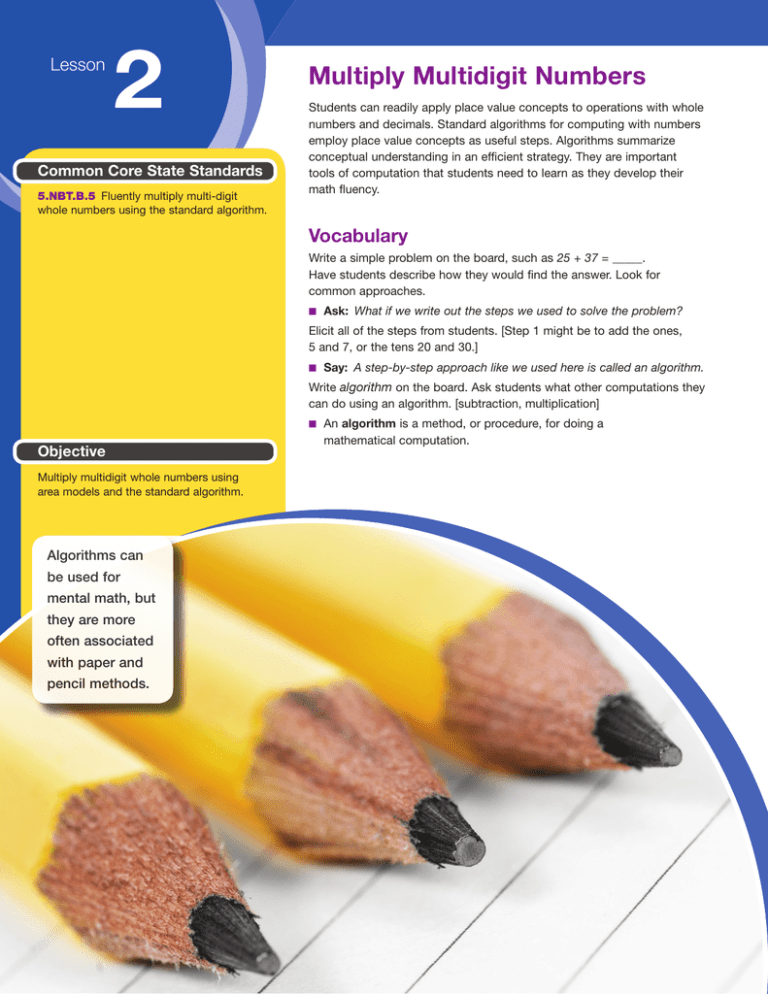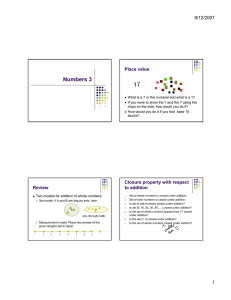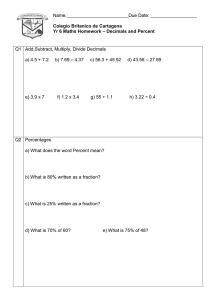Multiply Multidigit Numbers
advertisement

Lesson 2 Common Core State Standards 5.NBT.B.5 Fluently multiply multi-digit whole numbers using the standard algorithm. Multiply Multidigit Numbers Students can readily apply place value concepts to operations with whole numbers and decimals. Standard algorithms for computing with numbers employ place value concepts as useful steps. Algorithms summarize conceptual understanding in an efficient strategy. They are important tools of computation that students need to learn as they develop their math fluency. Vocabulary Write a simple problem on the board, such as 25 + 37 = _____. Have students describe how they would find the answer. Look for common approaches. ■■ Ask: What if we write out the steps we used to solve the problem? Elicit all of the steps from students. [Step 1 might be to add the ones, 5 and 7, or the tens 20 and 30.] ■■ Say: A step-by-step approach like we used here is called an algorithm. Write algorithm on the board. Ask students what other computations they can do using an algorithm. [subtraction, multiplication] ■■ An algorithm is a method, or procedure, for doing a Objective Multiply multidigit whole numbers using area models and the standard algorithm. Algorithms can be used for mental math, but they are more often associated with paper and pencil methods. mathematical computation. Operations with Whole Numbers and Decimals Set the Stage Engage WHOLE CLASS Present the problem 12 × 14 = __. ■■ Ask: How can you use place value as a strategy to find the product? Invite as many different responses as you can. Students might suggest decomposing 12 into 10 + 2 and finding the product as (10 × 14) + (2 × 14). Or they might instead suggest decomposing 14 into 10 + 4 and proceeding in similar fashion. If they suggest decomposing both factors, let them see if they can carry out that approach. ■■ Ask: How do these strategies help you? Acknowledge with students that the strategies may help them find the product mentally. At the minimum, they help students break down the problem into well-defined steps that will work every time. Warm-Up Foundation Skill Practice Use this short thinking exercise to jump-start the instructional session. Use this VersaTiles activity to help students activate their prior knowledge. ® Patterns and Products Answer Key Name 2 Find the missing number. Suppose you know that 14 × 10 is 140. You can use what you know about multiplication facts to find the product of large numbers. a. Tell how you can figure out what 14 × 11 is. b. Tell how you can figure out what 14 × 9 is. 60 × 30 = ■ Think: 6 × 3 = 18 60 × 30 = 1,800 So, 60 × 30 = 1,800. ■ × 8,000 = 560,000 Think: 7 × 8 = 56 70 × 8,000 = 560,000 So, 70 × 8,000 = 560,000. Find the missing number. ANSWER: a. 154, or (14 × 10) + 14; b. 126, or (14 × 10) – 14 COMMENTS & EXTENSIONS: It is important, especially when doing higher level math and when estimating, to be able to find shortcuts. 1 7 × 6 = 42, so 70 × 60 = ■ 2 8 × 6 = 48, so ■ × 60 = 48,000 3 4 × 2 = 8, so 40 × 200 = ■ 4 3 × 3 = 9, so 3,000 × 30 = ■ 5 5 × 4 = 20, so 50 × 4,000 = ■ 6 7 × 6 = 42, so 70,000 × 60 = ■ 7 9 × ■ = 72, so 90 × 800 = 72,000 8 5 × ■ = 45, so 50 × 900 = 45,000 9 3 × 8 = 24, so 30 × ■ = 2,400 10 2 × 7 = 14, so ■ × 70 = 14,000 11 4 × 9 = 36, so 4,000 × ■ = 360,000 12 9 × 2 = 18, so ■ × 200 = 180,000 Mental arithmetic: a. 99 × 32 = b. 9 × 14 = c. 16 × 101 = d. 15 × 102 = © ETA hand2mind® Tell how you got each answer. Operations with Whole Numbers and Decimals ■ Lesson 2 Hands-On Standards® Number & Operations Online resources available at hand2mind.com/hosnumbergr5 20 8 200 8,000 80 900 9 4,200 90,000 90 200,000 800 4,200,000 Objective: Use multiples of 10 to find a product or a factor. VersaTiles student book, page 20 ® 55 Introduce the Concept Explore WHOLE CLASS Distribute Base Ten Blocks and Factor Tracks. Have students build a model for 12 × 14, identify the four partial-product regions, and sketch the area model. rectangle built with 1 flat, 6 rods, 8 units Materials • Base Ten Blocks • Factor Track ™ The area model depicts the four main regions of the Factor Track model. Explore & Explain sso Le n 2 Name Multiply Multidigit Numbers Try This Model problem 1 using Base Ten Blocks and a Factor Track. Sketch your model. Label the area model, and complete the equation. ■ In problems 2–3, sketch an area model and find the product. ■ In problems 4–7, find the product. 10 1 10 5 100 50 10 5 10 10 1 10 10 5 1 5 = (____ × ____) + (____ × ____) + (____ × ____) + (____ × ____) 100 10 50 5 165 = ____ + ____ + ____ + ____ = ____ 15 60 50 200 325 10 3 4. 6. 26 × 33 225 × 32 20 5 200 50 60 15 10 40 400 150 600 6000 7200 7. ■ Lesson 2 125 × 23 15 60 300 100 400 2000 2875 5. 18 60 180 600 858 Operations With Whole Numbers and Decimals 3. 134 × 24 316 × 22 20 3 100 20 5 2000 400 100 300 60 15 16 120 400 80 600 2000 3216 12 20 600 120 200 6000 6952 Hands-On Standards® Number & Operations Online resources available at hand2mind.com/hosnumbergr5 56 100 40 2 20 8 sketch of area model 10 1,000 2 200 10 4 114 × 12 2 × 4 ➞ 8 100 40 2 × 10 ➞ 20 2 × 100 ➞ 200 10 × 4 ➞ 40 20 8 10 × 10 ➞100 10 × 100 ➞ 1,000 1,368 Explore & Explain SMALL GROUPS Prepare ahead Each group of students will need a set of Base Ten Blocks and a Factor Track. © ETA hand2mind® 25 × 13 10 100 1. 11 × 15 = (10 + 1) × (10 + 5) 2. 4 Change the problem to 12 × 114. This product is too big to model on the Factor Track, but you can have students apply the reasoning by sketching the area model. Write the problem in vertical format. Have students walk you through the computation using an algorithm. Answer Key ■ 10 The activity helps students internalize the basic ideas of multiplication with multidigit numbers. Students will build and sketch a manipulative model, sketch area models, and develop their fluency with the standard algorithm. They should reason that as long as the steps in their computations make sense, it doesn’t matter whether they start from the right or the left. Operations with Whole Numbers and Decimals Reinforce the Concept Explain & Elaborate WHOLE CLASS Re-Engage Have students describe their approach to Problem 7. Evaluate Use this page to give students additional concrete-to-representational-to-abstract practice. esso 2 3X n computation generates three pairs of partial products in which, for each pair, one product is 10 times the other. Have students explain the reason for this pattern. L ■■ Ask: Did you notice a pattern? Elicit that the Name Multiply Multidigit Numbers Answer Key Use a Factor Track and Base Ten Blocks to build the model. Complete the number sentence. WHOLE CLASS 2 2 2. 12 × 22 = (10 + _____) × (20 + _____) 1. 11 × 13 = (10 + 1) × (10 + 3) Present the area model— 2000 600 80 = (10 × 10) + (1 × 10) + (10 × 3) + (1 × 3) = (10 × 20) + (2 × 20) 100 + _____ 10 + _____ 30 + _____ 3 143 = _____ = _____ 10 2 + (_____ × 2) + (_____ × 2) 200 + _____ 40 + _____ 20 + _____ 4 264 = _____ = _____ 60 200 8 Complete the area model for the problem. Find the product. 3. ■■ Say: This is the area model for a multiplication problem. 26 × 13 18 60 60 200 338 Figure out what the problem is and determine the product. [22 × 134 = 2,948] 10 3 20 6 200 60 60 18 4. 100 40 4 20 2000 800 80 4 400 160 16 144 × 24 16 160 400 80 800 2000 3456 Find the product. Use this VersaTiles activity to give students more practice with the skills they learned in the lesson. 5. 46 × 34 7. 225 × 31 ® Products on the Loose! 24 160 180 1200 1564 5 20 200 150 600 6000 6975 6. 127 × 14 8. 333 × 26 28 80 400 70 200 1000 1778 18 180 1800 60 600 6000 8658 © ETA hand2mind® Independent Practice Find the product. 1 18 × 538 2 41 × 743 3 26 × 256 4 35 × 936 5 53 × 819 6 70 × 432 7 13 × 3,795 8 34 × 1,306 9 28 × 4,752 10 51 × 2,371 11 25 × 3,413 12 62 × 1,268 44,404 30,240 43,407 133,056 120,921 32,760 30,463 78,616 6,656 85,325 9,684 49,335 Operations With Whole Numbers and Decimals ■ Lesson 2 Hands-On Standards® Number & Operations Online resources available at hand2mind.com/hosnumbergr5 Daily Routine Anchor Poster Find the product. 1 15 × 424 2 398 × 23 3 167 × 60 4 925 × 32 5 71 × 576 6 43 × 729 7 25 × 1,315 8 38 × 3,120 9 17 × 2,550 10 46 × 1,678 11 235 × 45 12 112 × 12 1,344 9,154 32,875 77,188 40,896 43,350 31,347 118,560 6,360 29,600 10,020 10,575 Objective: Find the product of a 3- or 4-digit number multiplied by a 2-digit number. Review with your class the concepts of area models and the distributive property. Create an anchor poster with students. Include area models for single-digit and two-digit multiplication, with examples. Place the poster in the writing center. Writing assignment: Create a third example to add to the anchor poster about multiplying a three-digit number by a two-digit number. 21 VersaTiles student book, page 21 ® 57 sso Le n 2 Multiply Multidigit Numbers Name Try This ■■ Model problem 1 using Base Ten Blocks and a Factor Track. Sketch your model. Label the area model, and complete the equation. ■■ In problems 2–3, sketch an area model and find the product. ■■ In problems 4–7, find the product. 1. 11 × 15 = (10 + 1) × (10 + 5) = (____ × ____) + (____ × ____) + (____ × ____) + (____ × ____) = ____ + ____ + ____ + ____ = ____ 2. 25 × 13 3. 125 × 23 4. 26 × 33 5. 134 × 24 6. 225 × 32 7. 316 × 22 Operations With Whole Numbers and Decimals ■ Lesson 2 © ETA hand2mind® Hands-On Standards® Number & Operations Products on the Loose! Find the product. 118 × 538 241 × 743 326 × 256 435 × 936 553 × 819 670 × 432 713 × 3,795 834 × 1,306 928 × 4,752 ••51 × 2,371 ••25 × 3,413 ••62 × 1,268 44,404 30,240 43,407 133,056 120,921 32,760 30,463 78,616 6,656 85,325 9,684 49,335 Find the product. 115 × 424 2398 × 23 3167 × 60 4925 × 32 571 × 576 643 × 729 725 × 1,315 838 × 3,120 917 × 2,550 ••46 × 1,678 ••235 × 45 ••112 × 12 1,344 9,154 32,875 77,188 40,896 43,350 31,347 118,560 6,360 29,600 10,020 10,575 Objective: Find the product of a 3- or 4-digit number multiplied by a 2-digit number. 21 2 3X Name Multiply Multidigit Numbers Use a Factor Track and Base Ten Blocks to build the model. Complete the number sentence. 1. 11 × 13 = (10 + 1) × (10 + 3) 2. 12 × 22 = (10 + _____) × (20 + _____) = (10 × 10) + (1 × 10) + (10 × 3) + (1 × 3) = (10 × 20) + (2 × 20) = _____ + _____ + _____ + _____ = _____ + (_____ × 2) + (_____ × 2) = _____ + _____ + _____ + _____ = _____ Complete the area model for the problem. Find the product. 20 3. 26 × 13 6 4. 144 × 24 10 3 Find the product. 5. 46 × 34 6. 127 × 14 7. 225 × 31 8. 333 × 26 Operations With Whole Numbers and Decimals ■ Lesson 2 © ETA hand2mind® L n esso Hands-On Standards® Number & Operations



